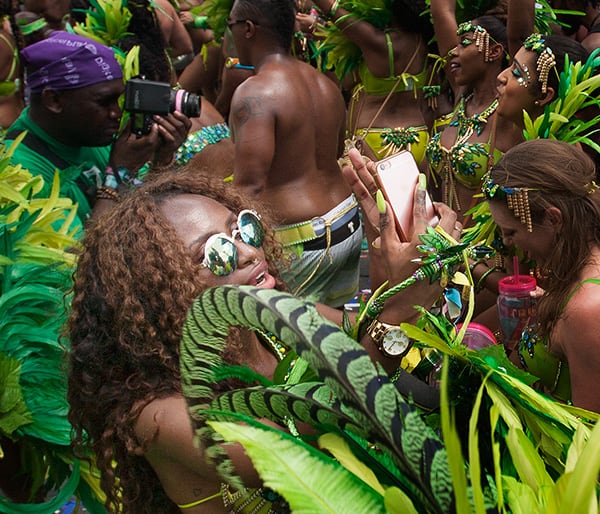
Above: A masquerader in Tribe takes a moment for a selfie as the band crosses the stage at the Socadrome. Photo by Mark Lyndersay.
BitDepth#1028 for February 16, 2016
In 1979, I did my first documentary work on Carnival, a multimedia project produced on the side at a PR agency I worked for, with their blessing and financial support.
Back then, multimedia was two synchronised slide projectors and a recorded tape to pull the visual narrative together.
It was the first time I would meet and photograph Peter Minshall, whose bell-bottomed Carnival of the Sea splashed onto the Savannah stage with vigor, led by Peter Samuel’s fierce reading of the band’s king, The Manta Ray.
The agency owned the presentation, and those images, having paid the admittedly high toll of slide film expended in the capturing of it, but I would record Mr Minshall talking about his creation, my first, admittedly giddy encounter with his expositions on “the marse.”
I believe that entire project and the supporting work is lost now, but I thought of it as I found myself immersed, even drowning a little in the Carnival of the Selfie, the inexorable final act in a repositioning of the documentary process and responsibility for capturing images of mas in motion.
Minshall’s Carnival of the Sea was a demonstrative, exposition driven work, its successive costumed waves revealing more of the designer’s interpretation of the ocean and his efforts to create that organic ebb and flow on the dusty stage in the heat of the afternoon sun.
For most of the last two decades, the masquerade of Carnival Tuesday has been withdrawing from that kind of bold theatrical statement, narrowing its focus first to the unblinking glass eyes that lined the stage and stared in from platforms above, then condensing the expansiveness of a stage performance into little vignettes performed for cameras that reached ever deeper into the mass of costumes.
They swooped in on cranes, then dove in, pointed fiercely by photographers and videographers keen for identiable intimacy in the face of an orgy of colour and movement.
I’ve written about the consequences of this photographic sniping on Carnival coverage before (in 2011, in 2012- here and particularly here, and in 2014) , so I shall not belabor that subject now, not least because those concerns seem about to become irrelevant.
With smartphone photography the default for personal communication and Internet access assured on most of these devices, the confluence between masquerader, documentation and social media sharing arrived decisively for Carnival 2016.
Two young photographers took note of the trend (full responses here) with their photographs.
Nisha Kong, who has been photographing Carnival since 2009, explained that, “People seemed more caught up either Skyping on stage, taking selfies or doing videos on their phones and others seemed downright bored and dancing was either short bursts of energy followed by posing or walking off the stage.”
“At one point it seemed like the story was – taking photos of people taking photos of themselves – which wasn’t worth the time in the sun and I ended up calling it a wrap by lunchtime Tuesday.”
Sarita Rampersad, who has photographed traditional mas, shot pretty mas for the first time on Carnival Tuesday (FB gallery).
When I realised that the ends of the stage were mostly blocked by a line of photographers and security,” Rampersad said, “I took some time to look around to see what else caught my eye, and that’s when I noticed a proliferation of masqueraders on their phones.”
“I took many photos like that. You would see a shot of a girl on the phone for instance, surrounded by friends, and about 10 minutes later I’d take another shot in that same location, and she would still be on her phone, with her friends looking bored next to her.”
“Funny. I’m not anti-phone by any means – I use mine all the time, and I appreciate wanting to take pictures, needing to let friends know where you are and arrange meeting points, but what struck me repeatedly was how engrossed the masqueraders were in their devices to the exclusion of what was happening around them and how removed people were from Carnival.”
This was the year that saw masqueraders, already fixated on creating the perfect moment of themselves on the stage, actually turning away from photographers to take their own photographs.
This was so meta, so very much about itself, that taking a picture of someone taking a photo of themselves seemed to be an almost pornographic voyeurism, a moment so perfectly masturbatory that it dispensed with the need for something as general and perhaps now as superfluous as the idea of third-party Carnival coverage.
In place of a strategic journalistic approach to documenting a parade of the bands, there is now, fuelled by enabling technology, a stream of real-time imagery emanating from within the band, by itself, of itself and perhaps, ultimately, for itself.
This aggressive cutting out of the middleman, the newspaper supplements and magazines, the official band magazine, the party focused website, is only likely to multiply in coming years.
Technology will only continue to enable this phenomenon. Selfie sticks are becoming more pervasive, front facing cameras are being improved steadily, even as their angle of view increases and the software controlling them increasingly encourages the documentation of the self.
What need then for curated snapshot albums printed on glossy paper and sold on the streets when you’ve already notified your acquaintances, friends and family, via dozens, perhaps hundreds of spot updates delivered via social media conduits, of “The present situation.”



Well said Mark. Interesting commentary. This is also pervasive in many other aspects of life as well; travel, New Years Celebrations, Christmas dinners, ..first dates…